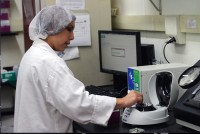With nearly one in every six Americans falling prey to foodborne illnesses each year, food safety is a major public health issue. For several decades, current Good Manufacturing Practices (cGMPs) provided the basic food safety framework for manufacturers. However, these guidelines were not sufficient to cover all potential food safety hazards. In the 1960s, NASA asked Pillsbury to manufacture the first foods for space flights, and so the Hazard Analysis & Critical Control Point (HACCP) system was born. HACCP was later endorsed by the Codex Alimentarius Commission, which was formed by the Food and Agriculture Organization of the United Nations and the World Health Organization in 1963.
HACCP is a global standard and its principles are the defining elements of ISO 22000, BRC and SQF, all premiere global food safety standards. In 1996, an E. coli outbreak in Scotland claimed 10 lives. The Pennington report in the aftermath of this tragedy recommended use of HACCP by all food manufacturers to ensure food safety. While HACCP is mandatorily used for seafood, juice and USDA-regulated meat processing, it could not win universal acceptance across the food industry; most of the food industry sectors rely on cGMP for providing a food safety framework.
The number of people affected by foodborne illnesses can be attributed to a flawed food safety system. Thinking caps were put on and President Obama’s administration rigorously pursued what it hoped would be an effective food safety paradigm. On July 4, 2012 Hazard Analysis and Risk Based Prevention Control (HARPC) was introduced under FSMA section 103. Although the system is still a work in progress and FDA has yet not disclosed the regulations that will determine the functionality of HARPC, the agency is bound to issue the regulations by August 30, 2015. HARPC will become effective 60 days following this date, and companies will be required to enforce HARPC within a period of 12 to 36 months, depending on the size of a facility.
HARPC is designed along the lines of HACCP but is meant to be more comprehensive. For a “Simple Simon” it would be tough to differentiate between the two, but HARPC provides an all-encompassing food safety structure by focusing on preventive controls to make food safety more iron clad. With the exception of exempted facilities, HARPC will apply to all facilities subjected to FDA’s Bioterrorism Facility Establishment registration. All such facilities will be expected to enforce a functioning and adequate HARPC plan. Failure to do so and FDA would be authorized to take legal actions such as issuing a public warning letter or an import alert (in case of a foreign supplier), initiating criminal proceedings against a non-compliant facility, or suspending food facility registration of a facility until requirements are met. By doing so, FDA has put the onus squarely on the shoulders of respective facilities. Companies will be required to do a lot more and should expect deeper FDA involvement. Expert help to enforce a rather complex HARPC protocol seems unavoidable; there is a fair chance that users could find themselves lost in the translation and may end up facing FDA’s wrath if their plan is inadequate. Let me break it down a bit more and distinguish the main differences between HARPC and HACCP.
Qualified Food Safety Experience. HARPC requires one member of a company to be the qualified individual to complete an entire food safety plan. This means that said individual has undertaken education from a credible institution and gained experience by completing it. HACCP requires at least one person to be HACCP certified, but the plan must be constructed by a team of people.
Process Flow Diagram. Under the HACCP standard, food safety plans must include a clear flow diagram outlining the process, from start to finish, that the ingredients will take throughout your facility. HARPC has no regulations regarding this.
Hazard Variables. Traditionally, hazards were limited to biological, chemical and physical hazards under the HACCP paradigm. Yet, under HARPC, you must also outline Radiological and Terrorism hazards.
Controlling Hazards. Here is largely where the main difference lies: How to control a hazard. HACCP requires companies to mention their critical control points as well as outline a prerequisite program (PRP), although this has no set requirements. HARPC requires you to apply a sanitation preventive control to the hazards, which looks at monitoring, confirmation, corrective action, reviewing records and re-analyzing.
Reviewing the Plan. HACCP requires the individual in charge to review all HACCP documentation every year. This is in comparison to HARPC, which requires a facility to reanalyze its plan every three years.
Recall Plans. Recalls, as required under HARPC, are a special type of incident, with all of the attributes necessary to create and manage a recall plan. HACCP does not have such a requirement.
Use Software to Implement HARPC Plan
Using software can make life easier when it becomes time to implement a HARPC plan. Documentation is an important part of the HARPC system, and software can help generate most of the documents used to establish the plan. Such a system can link regulatory requirements with procedures and customize several aspects of the system during run time.
A risk analysis component of software helps a user identify the likelihood and severity of a particular hazard (a HARPC requirement). HARPC also requires sanitation control procedures at food surface contact points; software features can support cross contamination points to which hazards are assigned and controlled. Software also allows users to define equipment, with a facility to schedule and record calibration, maintenance, and verification activities, including management task assignment to satisfy HARPCs provisions regarding sanitation of utensils and equipment. In addition, it has the provision to document procedures as required by HARPC and can also flag employees for refresher training if they are involved in a violation.
Software also enables users to electronically record inspections, which satisfies the obligation under HARPC to carry out an environmental monitoring program (for pathogen controls). Interestingly, sensors could also be integrated with logging facilities to automatically collect sensor data, which could then be used to send out alerts if there is an abnormality. Software systems can also accommodate coverage of allergen hazards and run a food allergen control plan, including documentation of the process.
An incident management plan can assign and track corrective actions, root causes, employee retraining tasks, and preventive measures to individuals, and recall plans can be created and managed using the system. As many inspectors prefer remote review of documentation, software can provide such remote access, allowing inspectors to conduct off-site document reviews. This process can reduce on-site inspection times from five to three days. A list of approved suppliers can be maintained as well, and these suppliers can be linked to receiving functions, enabling users to receive and maintain a detailed and comprehensive record of ingredients.
HARPC is a reality that will have to be embraced very soon. Using software is a simple solution for the tough times that lay ahead for the food industry. It can serve as an all-encompassing and one-stop-shop for businesses that need help enforcing HARPC plans.











 PerkinElmer Inc., a global leader focused on improving the health and safety of people and the environment, today announced the launch of its Adulterant Screen™ software. This automated solution can help food industry professionals evaluate the integrity of food ingredients to guard against existing and potential food adulteration threats.
PerkinElmer Inc., a global leader focused on improving the health and safety of people and the environment, today announced the launch of its Adulterant Screen™ software. This automated solution can help food industry professionals evaluate the integrity of food ingredients to guard against existing and potential food adulteration threats.
